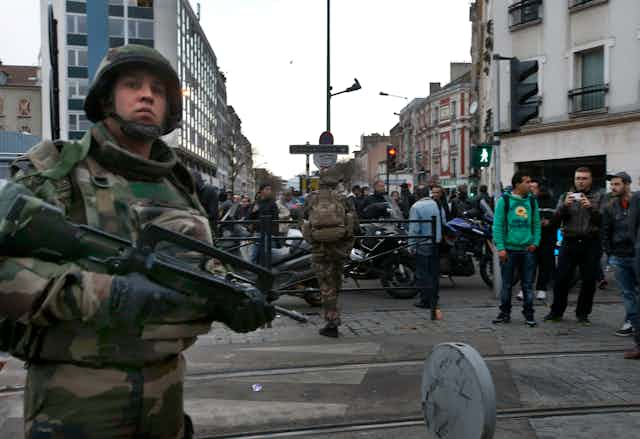The attacks carried out in Paris on November 13 were low tech, simple and devastating. A small band of Islamic State fighters proved capable of carrying out multiple assaults on bars, restaurants, a concert hall and the Stade de France, leaving 129 people dead and several hundred others injured.
What is particularly troubling for the authorities is that these attacks occurred at a time of exceptionally high security throughout many parts of France. Following the attacks that took place in the city in January, the French authorities had already deployed groups of heavily armed paratroopers. Teams were patrolling French cities, buttressing the already heightened policing and intelligence efforts. They could be seen around transport hubs, tourist attractions and other crowded places.
But what they feared and planned for came true, and the troops on the streets failed to prevent the slaughter.
These “soft target” attacks amply demonstrate the difficulties faced by any government when trying to keep their citizens safe. In reality, the authorities are always behind the curve, and adversaries are opportunistic and adaptive. They respond quickly to new security innovations, creating an “arms race” between attacker and defender.
What is described as “terrorism” is best thought of as a tactic – one used by the weak against the strong. IS knows it can never defeat a modern, well-equipped European army, but it can infiltrate the heart of a European capital and bring the battle to its streets. In doing so, it is not only able to create fear and havoc, it can badly damage the tourist economy.
Designing safety
Most people going about their daily lives don’t realise that our cities are increasingly being built or retro-fitted to supposedly design out vulnerability to terrorism.
In the UK especially, but also elsewhere in some parts of Western Europe, efforts have primarily focused on preventing two types of potent threat – vehicle-borne IEDs, (rammed into crowded places or left close to them) and bombs (left and remotely detonated).

That is why you constantly hear announcements at stations and airports warning you not to leave your bags unattended. It’s also why you see rows of bollards and other design features outside important buildings and station perimeters. These are added to extend blast “stand-off” distances, keeping the bomb from getting close to the intended target and thereby reducing its destructive capacity.
The bombings on the London underground on July 7 2005 and in Madrid on March 11 2004 dramatically highlighted the vulnerability of train stations and transport hubs more generally.
That has affected how new stations are built. Typically, they are now designed with clear sight lines, using smooth panelled walls with no nooks or crannies. They are generally open, well lit and uncluttered spaces, with little furniture.
But arms races are dynamic – and security experts admit (at least in private) that these measures are a double-edged sword. While aiding the early detection of suspicious items and behaviour, there’s a nasty rub. In a different attack context, these same carefully crafted, uncluttered and open spaces can increase vulnerability. Passengers who are unable to flee the immediate vicinity, for example, find themselves sitting ducks with nowhere to hide from determined gunman bent on killing as many people as possible before the cavalry arrives.

This is the arms race going wrong. It demonstrates the central predicament of counter measures – they can be used against defenders. Survivors of the 2008 Mumbai and 2013 Kenya attacks survived precisely because they were able to hide, facilitated by the type of buildings in which they found themselves captive.
In future, paying attention to these details – and the possible consequences – will only become more important.

